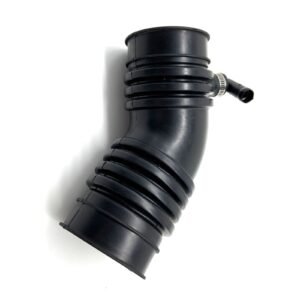Air intake rubber hoses play crucial roles in power generation applications, particularly in the air intake systems of generators and power plants.
Here’s how these hoses are used and the functions they perform in power generation:
- Air Filtration: Air intake rubber hoses are connected to air filters within the air intake system. These filters trap airborne particles and contaminants, ensuring that only clean air enters the generator or power plant. This is essential for preventing damage to internal components and optimizing combustion.
- Airflow Regulation: The hoses help regulate the airflow entering the power generation system. By providing a controlled and efficient pathway for air intake, rubber hoses contribute to the proper functioning of the combustion process and overall system efficiency.
- Engine Combustion: In power generation systems with internal combustion engines, air intake rubber hoses deliver air to the combustion chamber. The quality and quantity of air supplied through these hoses are critical for efficient fuel combustion, which directly impacts power output.
- Flexible Connections: Air intake rubber hoses provide flexibility in the design and installation of air intake systems. They can adapt to different configurations, allowing for easier connection between air filters, turbochargers, and the engine itself.
- Vibration Dampening: Power generation systems, especially large generators and engines, generate significant vibrations during operation. Air intake rubber hoses help dampen these vibrations, reducing the transmission of mechanical shocks to the system and improving overall stability.
- Temperature Resistance: Rubber hoses are designed to withstand a range of temperatures, contributing to the efficient regulation of air temperature within power generation systems. They ensure that the air entering the system is at the desired temperature for combustion and cooling processes.
- Sealing: Air intake rubber hoses provide a sealed connection between the air intake components. Proper sealing is crucial for maintaining the efficiency and reliability of power generation equipment by preventing the ingress of unfiltered air or contaminants.
- Corrosion Resistance: In certain power generation environments, there may be exposure to corrosive elements. Air intake rubber hoses are often made with materials that resist corrosion, ensuring the longevity of the hoses and their ability to perform effectively in harsh conditions.
- Turbocharger Connections: In some power generation systems, turbochargers are used to increase air pressure and improve combustion efficiency. Air intake rubber hoses are employed to connect the turbocharger to the air intake system, ensuring a smooth flow of pressurized air.
- Cold Weather Applications: Air intake rubber hoses maintain flexibility even in cold weather conditions, making them suitable for power generation systems operating in diverse climates. This flexibility allows for consistent performance, regardless of temperature variations.
In summary, air intake rubber hoses are integral components in power generation applications, contributing to the efficiency, reliability, and longevity of air intake systems. Their functions include air filtration, regulation of airflow, combustion support, and the provision of flexible and durable connections within the power generation equipment.
Can you describe the specific applications of air intake rubber hoses in construction equipment?
Air intake rubber hoses in construction equipment serve various crucial functions to ensure optimal performance and longevity of the machinery.
Here are specific applications of air intake rubber hoses in construction equipment:
- Engine Air Intake: Air intake rubber hoses connect the air filter to the engine’s intake manifold, providing a sealed pathway for filtered air to enter the engine. This is essential for the combustion process, as clean air is necessary to achieve efficient fuel combustion and maintain engine performance.
- Dust and Debris Protection: Construction sites are often dusty environments. Air intake rubber hoses, in conjunction with air filters, help protect the engine from dust, debris, and other particulate matter. They prevent these contaminants from entering the engine, reducing the risk of engine wear and damage.
- Preventing Water Ingress: Construction equipment may operate in environments where water exposure is a concern. air intake rubber hose Air intake rubber hoses are designed to be water-resistant and prevent the ingress of water into the engine. This is crucial for avoiding water damage and ensuring the engine’s reliability.
- Adaptability to Engine Movements: Construction equipment is subject to vibrations and movements during operation. Air intake rubber hoses are flexible and can adapt to these movements, providing a durable and reliable connection between the air filter and the engine intake manifold.
- Temperature Regulation: Rubber hoses used in air intake systems are designed to withstand a range of temperatures. In construction equipment, where operations can take place in diverse climates, these hoses contribute to maintaining the optimal temperature of the air entering the engine for combustion.
- Flexible Installation: Construction equipment often has varying engine layouts and configurations. Air intake rubber hoses offer flexibility in design and installation, accommodating different orientations and ensuring a secure connection between the air filter and the engine intake.
- Resistance to Environmental Conditions: Construction sites expose equipment to harsh environmental conditions, including UV exposure, chemicals, and abrasion. Air intake rubber hoses are formulated with materials that resist these environmental factors, ensuring durability and a longer service life.
- Compatibility with Construction Fuels: Some construction equipment operates on specific fuels or fuel blends. Air intake rubber hoses must be compatible with the fuels used in the equipment to prevent degradation and ensure optimal engine performance.
- Engine Efficiency: By delivering clean and filtered air to the engine, air intake rubber hoses contribute to the overall efficiency of the engine. This, in turn, helps maintain the equipment’s performance and productivity on construction sites.
- Maintenance Ease: Air intake rubber hoses are designed for ease of maintenance. Quick and secure connections make it simpler to replace air filters and inspect the air intake system during routine maintenance checks, reducing downtime for construction equipment.
In summary, air intake rubber hoses in construction equipment play vital roles in protecting the engine, ensuring efficient combustion, and adapting to the challenging conditions of construction sites. Their design features contribute to the overall reliability and longevity of construction machinery.
